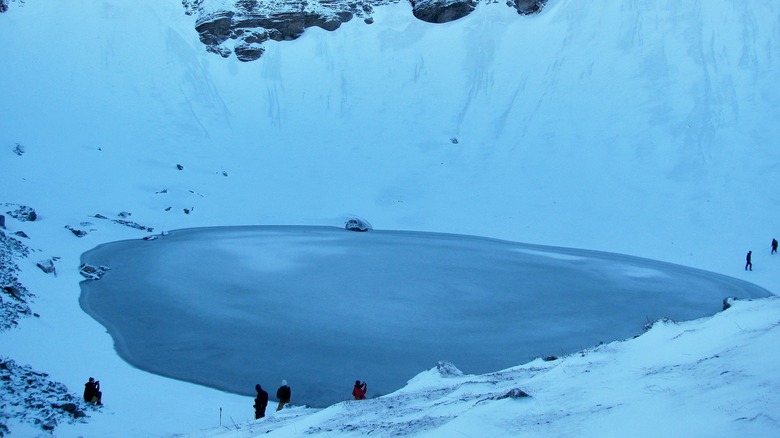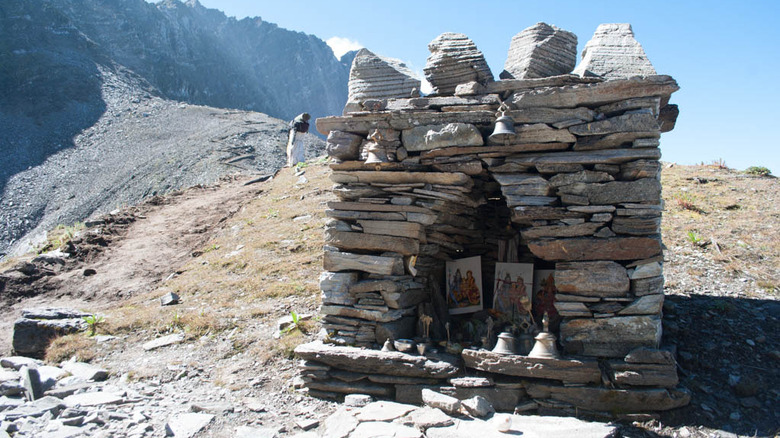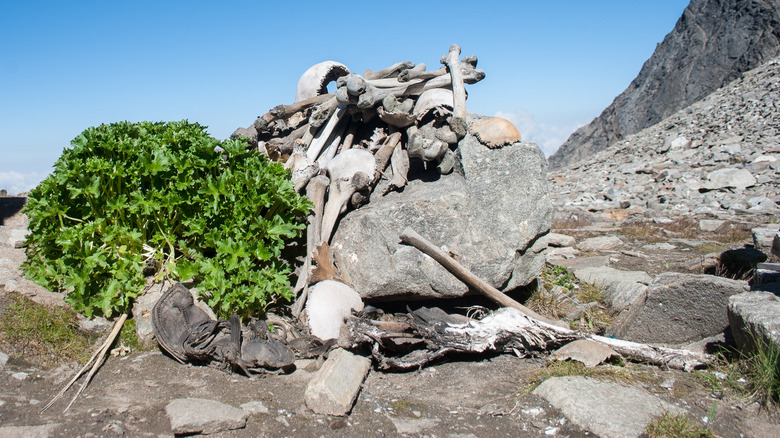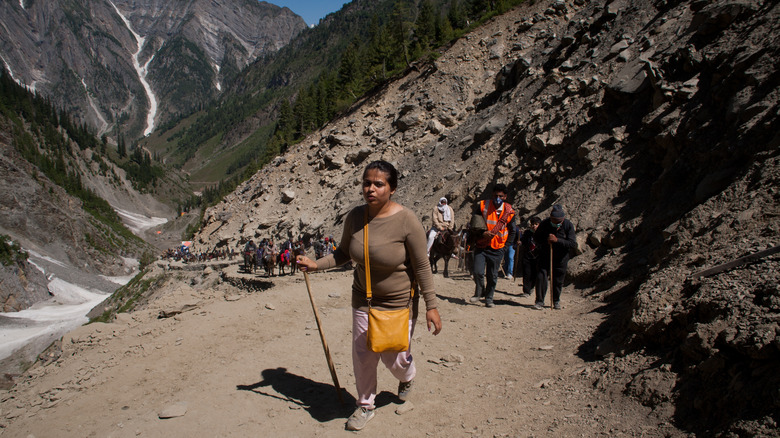The Disturbing History Of India's Bone-Filled Roopkund Lake
At this point in time it's easy to imagine that there's nothing left to explore or discover on our planet. After all, tools like Google Earth let users zoom down from orbit right to their own roof. We've got tours and visitors' guides to the most obscure, remote, and inaccessible places on the globe. Sites like Airbnb offer deluxe mountainside cabin experiences in locations that would have taken people days to hike to in previous centuries. And yet, sometimes it's nice to get a reminder that mysteries still exist, right here on Earth and not out in space. Even our own oceans, which cover 70% of the planet's surface, have only been 5% mapped.
This is where sites like Roopkund Lake come into play. Located in the Himalayan mountains in the Indian state of Uttarakhand at a height of 15,700 feet, Roopkund Lake is home to a mystery as macabre as it is bizarre. The 80 years of research and probing since its accidental discovery in 1942 have left us with many, many unanswered questions about the 800 or so skeletons found in and around the lake. Explanations start with dead Japanese soldiers circa World War II, Silk Road traders who died en route, a raging goddess that took out her revenge on pilgrims, a lethal and sudden hailstorm, and conclude with DNA analysis of the bones revealing connections to the Mediterranean island of Crete in modern-day Greece.
[Featured image by Neha iitb via Wikimedia Commons | Cropped and scaled | CC BY-SA 4.0 DEED]
Hidden deep in the Indian Himalayas
The mountains of Uttarakhand, India are so vast, grand, and wide-reaching that it's no wonder Roopkund Lake remained unknown all the way until 1942 — except to those who'd died there, of course. Back then, an Indian forest official named H.K. Madhwal stumbled across not only the lake but hundreds of bones in and around the water.
Almost no skeleton at the lake was complete, and no skeleton showed evidence of death by violence. There was also no evidence of death by illness or ritual suicide, and most of the dead were between 18 and 35 years old. The remains included men, women, and children who left nothing behind but bits of leather slippers, pieces of parasols made from bamboo, and bangles made from glass or seashells. By all accounts it seems the cold mountain air had helped preserve the remains. Eventually, Roopkund Lake earned the nickname, "Skeleton Lake."
Initially, suspicions about the bones — strangely enough — pointed to Japanese soldiers sneaking through the mountains, possibly because 1942 fell in the middle of World War II. Other suspicions pointed to the Silk Road, the ancient trade route between Rome and China that also passed down through the Indian Himalayas and out to the Bay of Bengal. If the latter was true, then the traders would have died for some reason when stopped at the lake. Later analyses, however, revealed very different answers, and two entirely different sets of bones.
An ancient Hindu pilgrimage site
Neelima Vallangi on the BBC describes trekking to Roopkund Lake. She heard tales on the way about a goddess who'd grown angry with "irreverent pilgrims" and dancers at the lake, whom she apparently turned to stone, Medusa-style. National Geographic elaborates on the story and describes a Hindu pilgrimage in the area called the "Raj Jat" that happens every 12 years. The goddess in question is Nanda Devi, a partner of Shiva — one of the three chief deities of Hinduism — and incarnation of Shiva's wife, the goddess Parvati. In this version, Nanda Devi killed the pilgrims using "iron balls" hurled from the sky.
Nanda Devi is also the name of a nearby mountain that rests a short distance from Roopkund Lake. The mountain is the second-highest in India, at about 25,600 feet tall. And indeed, even nowadays there are still actual pilgrimages through the region equaling over 170 miles and taking 19 days. Such pilgrimages, which involve traditional dances and worship songs, end right at Roopkund Lake.
Back in 2004, as the BBC says, professor of archaeology Veena Mushrif-Tripathy at Deccan College in Pune, India concluded that the most plausible theory is that the bones at Roopkund Lake belonged to pilgrims. The dead included non-soldiers, and evidence also uncovered bits of instruments that would have been included in pilgrimages. And those "iron balls" from the Nanda Devi story? They might have been hailstones that pounded the region in a single, 9th-century event.
[Featured image by Daniel Romanson via Wikimedia Commons | Cropped and scaled | CC BY-SA 4.0 DEED]
Deadly hail and an angry goddess
If death by hail sounds implausible, AccuWeather reminds us that while extremely rare, it's possible. In 2000, a softball-sized hailstone hit a 19-year-old Texas man and killed him. In 1995 a hailstorm tore through the Dallas-Forth Worth area during a music festival and seriously injured 60 people. And the World Meteorological Organization says back in 1888, a hailstorm in India killed a staggering 246 people with hail the size of "goose eggs, oranges, and cricket balls." And if such events happened in recent history, you can bet they were possible in ancient history.
A deadly hailstorm pummeling a religious event full of music and dancing would have been seen as a grim omen, indeed — the kind to give rise to the story of the goddess Nanda Devi chucking "iron balls" down on the impious at Roopkund Lake. Another version of this story on Savaari describes a local king, Jasdhawal, wanting to give thanks to Nanda Devi for his newborn baby by taking the above-described pilgrimage through the region. Priests warned Jasdhawal to keep things quiet, respectful, and modest at Roopkund Lake, but he didn't listen. And so, Nanda Devi flattened the king, his wife, newborn baby, and entire retinue. In this version of events, the bones of those present belong to not just pilgrims, but royalty — royalty punished for being disrespectful at a holy site.
Others think that it wasn't pilgrims passing through the area at all, but folks in search of mushrooms to make into medicine.
DNA mysteries from the Mediterranean
If the whole "pilgrims killed by freak hailstorm" angle seems like we've closed the book on Roopkund Lake and it's bones, recent DNA evidence from 2019 has only deepened the mystery. As an article in Nature Communications explains, a DNA analysis of 38 skeletons from Roopkund Lake revealed 23 people having DNA matching present-day nearby nations of India, Pakistan, Nepal, Bangladesh, and so forth — this is expected. But, the analysis also revealed 14 other people having DNA from the far-flung Mediterranean thousands of miles away. Specifically, these individuals had DNA from the island of Crete south of mainland Greece, home to the ancient Minoan civilization (3,000 to 1450 B.C.E.) and tales of the Minotaur and his labyrinth.
While tempting, it would be a mistake to jump to conclusions about ancient Minoans somehow trekking across Asia Minor and into the Himalayas, or to concoct tales of ancient cultural and economic exchange between the two regions. Namely, the study in question points out that the two discovered DNA groups — South Asian and Mediterranean — were separated by about 1,000 years of time. This would place the Greeks in the 19th century.
This new information only raises more questions, like, "Who were these Greeks?" and, "Did they also die from a hailstorm?" In fact, as the BBC quotes study co-author Veena Mushrif-Tripathy, despite evidence of a hailstorm in the region, only six or seven people at Roopkund Lake showed signs of head trauma caused by hail.
[Featured image by Schwiki via Wikimedia Commons | Cropped and scaled | CC BY-SA 4.0 DEED]
Spearheading the Indian trekking scene
Even though Roopkund Lake isn't extremely well-known around world, it's served to not only foster stories about an angry goddess and killer hail but also spearhead India's trekking industry as of 2009. The BBC reports that an unnamed company based in Bangalore in India's south launched a website allowing the purchase of group trek tickets to Roopkund Lake. While there's no telling how many non-Indian people took part in this excursion, well-to-do Indians with more disposable income were definitely able to sign up. The author of the BBC article in question mentions her own trek taking a week and spanning over 30 miles.
Nowadays, even only a quick search online reveals outdoors businesses like Trek the Himalayas offering guided expeditions to Roopkund Lake. Discussions on sites like Quora, meanwhile, discuss the difficulty of the journey. The aforementioned BBC article describes how trekkers often joke about slipping on the 650-foot descent from Junargali Pass down to Roopkund Lake and adding their bones to the heap below. Those bones, it should be noted, stay trapped within Roopkund Lake when it's frozen, and then appear every summer when the ice melts.
Barring further investigations and insights into the origins of the dead at Roopkund Lake, the site's turn to a tourist destination for the intrepid is where its history ends. Those trekking to the site might take care not to be too noisy, however, or else once again rouse the anger of Nanda Devi.





